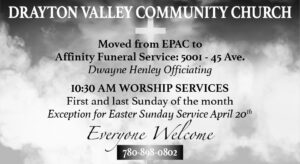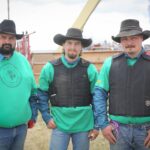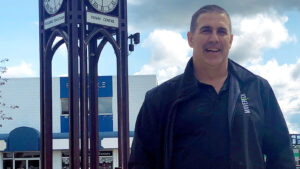Amanda Jeffery, Free Press
Anyone who is 55 years or older will soon be able to access a vehicle to get them to all of their appointments in town, and to some appointments outside of the community.
Drake’s Handi-Bus Services is now being contracted by the Town of Drayton Valley to help those who are older than 55 and those with mobility issues (at any age). Annette Driessen, the General Manager of Community Services for the Town, says they put an RSP out into the community, checking to see if there was anyone who wanted to operate the service, and Drake’s was the one who won.

Drayton Valley Community Church
DV Community Church. Located at Affinity Funeral Services, officiated by Dwayne Henley.

Living Spirit United Church
Everyone welcome. Sunday Worship, 10:30 We are residents of Drayton Valley, members and adherents of

St. Anthony Catholic Church
St. Anthony’s Parish Drayton Valley. Weekend mass Saturday and Sunday

Valley Gallery and Framing
Share on facebook Facebook Share on email Email Share on linkedin LinkedIn Share on whatsapp

Drayton Valley Insurance
Share on facebook Facebook Share on email Email Share on linkedin LinkedIn Share on whatsapp
“Providing accessible transportation in Drayton Valley has been a priority of Council and I am excited to see this important project come to fruition. Town Council remains committed to offering yearly grants to keep this service operating for the betterment of the community,” says Mayor Michael Doerkson in an email statement.
Amy Newberry, of Drake’s Handi-Bus Services, says the name has historical meaning for the community. “The Drakes were the people of our town that named Drayton Valley because of the Postal Code system, and they were also my great grandparents. It’s a form of leaving a legacy for me,” she said via email.
Experience the rich history of Drayton Valley and Brazeau County with a visit to the Drayton Valley Museum!
Conveniently located just off Cowboy Trail, AB-22, the Drayton Valley Museum showcases the history of a community that never gives up.
Explore the museum’s five historic buildings with displays of the agricultural, oilfield and pioneer history of Brazeau County, and take a step back in time to discover the lives of some of Drayton Valley’s earliest residents on a guided tour of the grounds.
With a variety of stories, objects, permanent and temporary exhibits, the Drayton Valley Museum is sure to have something to interest everyone!
Follow the museum on social media or watch their website for updated programs and events happening throughout their summer operational months. The museum is open seasonally (May-August) daily: 11am-5pm. Admission is free.
Museum Activity Ideas
Self Guided – Historic Walking Tour (Downtown Drayton Valley)
Special plaques have been created since 2013 to commemorate significant historic locations. Seven locations are recognized with plaques to date.
As you stroll along the sidewalks of our downtown area, let your imagination take you to a time where gas was just 20¢ a gallon, where the average home was under $20K ( although many of the roughnecks lived in skid shacks) and the mud was considered stickier than anywhere else! Enjoy!
Explore the Grounds – Open Air Exhibits
The Drayton Valley Museum has 5 historic buildings on their grounds that are part of there permanent exhibit collection. Click here to find out more about the history of each building.
Have a Picnic on the Grounds
The Drayton Valley Museum grounds have a number of picnic tables, they are also located near the playgrounds, and recreation fields located in West Valley Lions Park.
Join us Sunday Mornings 10:30 am
Everyone Welcome!
Phone: 780-542-6501
Email: office@dvalliance.ca
Mailing address:
Box 6578
Drayton Valley, AB T7A 1R9
At Drayton Valley Alliance Church we: preach the Word, love people, worship, pray, go and get to know Jesus better! Join us Sunday Mornings 10:30am at our new facility, 5012 56 Ave, beside Value Drug Mart.
Help is available to groups wanting to host events in the community.
Since 2015, the Town of Drayton Valley has been offering grants every quarter for non-profit organizations.
Lola Strand, the program manager with FCSS, says the Town sets aside $5,000 for each quarter. The deadline for the applications for the next grant is April 1.

St. Anthony Catholic Church
St. Anthony’s Parish Drayton Valley. Weekend mass Saturday and Sunday

Drayton Valley Community Church
DV Community Church. Located at Affinity Funeral Services, officiated by Dwayne Henley.

Life Church Drayton Valley
We know that exploring a new church can be an overwhelming experience. To help you

Living Spirit United Church
Everyone welcome. Sunday Worship, 10:30 We are residents of Drayton Valley, members and adherents of

Emmaus Lutheran Church
A community of faith passionately walking the road of life with the Lord Jesus. Phone: 780-542-5101, Drayton Valley Alberta
“Town council makes the decisions on the recipients of the grants,” she says.
She says council has other options they can do for the groups. In some cases, they can waive the costs of renting a town facility, or they might be able to have fees waived.
“It’s pretty flexible,” says Strand.
Strand says she collects the information from the applications and gives it to council so they can make an informed decision.
An all Canadian team that included a local resident was able to win the rodeo for the first time in the history of the World Famous Miles City Bucking Horse Cowboy Mardi Gras.
Wilfred Titanich was one of a team of three that attended the three-day event in Miles City, Montana from May 15-18. Titanich along with two brothers, Cory and Cody Loken, were the first all Canadian team to win at Bucking Horse since the first Miles City Bucking Horse Sale started in 1951.
Each member of the team came home with around $7,500 US, says Titanich.
“We got Championship Buckles and we got Championship Holders, too,” he says.
The team participated in the Wild Horse Racing event, which involves at least three people and an untouched horse. The horse starts out in the bucking chute and two members of the team follow the horse out, holding onto a long lead. One person is the mugger, and their job is to control the horse’s head by covering its eyes with his arm, which calms it and prevents it from rearing and hurting someone. The shanker holds onto the rope so it doesn’t run away. The rider saddles it, mounts, and holds on tight as they race to the finish line on a wild horse.
“Wild Horse Racing is one of the oldest events in rodeo,” says Titanich.
Though the event is called Wild Horse Racing, the horses used in the event are owned, but untouched.
Throughout the year, Titanich works the Canadian Wild Horse Racing Association Circuit, spending most of his time in Alberta, but also attending some events in B.C. and Saskatchewan, where he competes in both amateur and pro rodeos.
“Honestly, it’s really addicting,” says Titanich. “It looks really crazy, and it is pretty wild, but it’s super addicting. It’s an adrenaline rush in sport.”
He says he would encourage people who like competitive events to try Wild Horse Racing.
The Loken brothers have both been in the sport for about 15 years, says Titanich. Both of them were about 14-years-old when they first started out. Titanich has been in the sport for three or four years.
Normally, the Lokens race with their dad, Jason, and Titanich has his own team. But the three of them thought it would be fun to head down to Miles City for some fun.
The Bucking Horse Sale was a stand-alone event, says Titanich. His team is getting ready for the circuit this summer.
“We can rodeo every weekend from now to the end of October,” he says.
Anyone looking for information about which wild horse racing rodeos are coming up can visit www.wildhorseracing.ca. Titanich says he will be in Brooks at the Lea Park Rodeo this weekend and in Killam for the Killam Rodeo that will be held outdoors in Sedgewick this year.
An author who has written a non-fiction book that ties the Breton area to a mysterious child in Oklahoma will be visiting the Breton Library on June 7.
Russell Cobb, author of Ghosts of Crook County: An Oil Fortune, A Phantom Child, and the Fight for Indigenous Land is a Professor of Modern Languages and Cultural Studies at the University of Alberta. He was invited to the library by the Breton Library Board and the Breton Museum.
Allan Goddard, the manager of the Breton Museum, says he met Cobb when the author was working on the manuscript for the novel.
“He came out to the museum because there is a connection to the Hooks family,” he says.
Goddard says while the book does have some history about the Keystone area, and some relatives that may still live in the area, it is mainly about what indigenous families had to deal with in the early 1900s in Oklahoma.
Claire Sather, the Chair of the Board of Trustees for the Breton Library, says she read the book after finding it on Goodreads, a social media site dedicated to book ratings and reviews.
She says when she got to the end and saw a familiar name, Brandy Fredrickson, it really registered how close some events in the book are tied to the area.
Goddard says when Jim Crow laws came into being in Oklahoma, it triggered an exodus of African Americans from Oklahoma to seek out refuge in Canada. A group of those immigrants settled around Breton in the Keystone area in the early 1900s.
The book centres around a child named Tommy Atkins, whose existence has never truly been proven, and the oilmen who were snatching up indigenous lands in Oklahoma. Goddard says one of the women rumoured to be Atkins’ mother lived in Keystone for a while before returning to Oklahoma.
Both Sather and Goddard are excited to have him visit the Library, however, the space is limited. Those who wish to attend the event on Saturday, June 7th at 1 p.m. have to pre-register to ensure they get a spot.
Those who are interested can register by calling the library at 780-696-3740 or send an email to bretonlibrary@yrl.ab.ca.
Cobb has also written The Great Oklahoma Swindle: Race, Religions, and Lies in America’s Weirdest State.
Eighty years ago this week a group of men gathered in a room in Berlin to sign a piece of paper which brought an end to six years of war in Europe.
It was one of the most significant turning points of the last 1,000 years. It’s an event which will be remembered as well as any in the history of humanity. But history is very much what it is becoming.
World War II will never be forgotten, but it is rapidly becoming little more than a memory.
Anyone involved in the actual fighting would be, at the very least, in their mid-90s. Today the median age in Canada is somewhere around 40. That means the war belongs more to our grandparents’ generation than to our parents’. We’re now approaching the point where no one alive will remember World War II .
Sad as that may seem, it’s part of the inevitable ebb and flow of human events. Things move on. No one today mourns the 65,000 who died at the Battle of Waterloo or those who lost their lives at a thousand other places from Thermopylae to Gettysburg. Instead we are more likely to dress up as them and re enact the events of the day, for reasons that, I must confess, have never been entirely clear to me.
And so it will be with World War II. Certainly the events 25 years earlier at Ypres, the Somme and Passchendaele have now taken on a sepia tinge. They have gone from being a horrendous bloodbath to a historical curiosity.
Time moves on. It’s a natural process and not something we could reverse even if we wanted to.
Years ago I worked with a copy editor who would indignantly write “which one?” in the margins of any news story that simply referred to “the war.” At the time I thought he was a bit of a dickhead. But now, well, I’m still pretty sure he was a dickhead, but he may have been a dickhead with a point.
The world has been far from peaceful since May of 1945. For one thing, the war in Asia was still raging on this day in 1945 and would not end for a few more months with the fall of Japan. But, also this week in 1954 the French were defeated by the Vietnamese in the battle of Dien Bein Phu. This week in 1960 the Soviet Union announced it was holding American U2 pilot Gary Powers. This week in 1999 NATO accidentally bombed the Chinese Embassy in Kosovo. And if you checked the news this morning you probably saw that war continues in Ukraine. Tragedy is continuing to unfold in Gaza. And, well, you get the picture.
Still, by asking “which war” my former colleague may have been a little bit ahead of his time. When someone mentions “The War”most of us will immediately think of 1939-1945.
But time will prove my copy editor’s point. Events, even the most important events in the world, gradually fade into history.
It won’t happen overnight, but make no mistake, it will happen. The process is already under way.
In partnership with the University of Alberta’s Community University Partnership (CUP) town council will be looking at different ways that Drayton Valley residents can work to generate local wealth for the community.
Geraldine Cahill, the director of UpSocial Canada who works with CUP, along with Dr. Maria Mayan from the U of A, spoke to council about initiatives that other municipalities have taken on to help stimulate local economies.
CUP has been working in Drayton Valley since 2020, when they helped the Town develop the Zero Fee Tuition Program, now called the Tuition Assistance Bursary. The partnership was developed for a research project to explore whether the ZFT program could be a mechanism for an inclusive economy.
“The results so far have been very positive, both on employment and also for quality of life for participants,” said Cahill.
Cahill told council they had engaged with stakeholders during the research and found a strategy that they would like to explore with the Town. They believe that Rural Wealth Creation could be an effective initiative to help Drayton Valley navigate increased costs in a way that can benefit the entire community.
“Across the country there has been a pattern of downloading costs and responsibilities to municipalities… without much change in capital transfers,” said Cahill. “That puts a great deal of strain on municipal governments and single-resource towns have been hard hit by this.”
With RWC, the Town would work together with residents to develop ways that residents can invest in community projects as part of their retirement, thus ensuring a larger chunk of local money stays in the municipality.
Over the past few years communities across the country have achieved economic stability by using programs such as co-operatives, local procurement, employee ownership and other succession models, community bonds, community land trusts and more. Cahill also provided examples from some of the municipalities that have gone in this direction.
In 2002, the municipality of Westlock learned that their grain terminals were going to be sold. As agriculture was one of the important sectors for the community, there was concern about how the sale could affect the local economy. So, instead of letting the grain terminals go, the community worked together to raise $1.2 million to purchase the grain terminal.
Those who invested in the terminal now get yearly dividends for their investment. They also have the most profitable terminal for its size in Canada and are planning on diversifying into a transport company.
Cahill says that the size of the municipality may play a role in which type of community program would work best.
Mayor Nancy Dodds asked Cahill how the Town could move forward with the plan as they would have to play a role in whatever path residents choose to move forward with.
“As the Town, as leaders, we want to be involved, but we don’t want to be getting in the way,” said Dodds. “How do you make sure that everyone has their say when you’re picking that.”
CUP has a workshop planned for May 5 at Clean Energy Technology Centre to help brainstorm some ideas that may work in the community. Cahill says everyone is welcome to attend and they will be looking at community assets as well as asking attendees what their priorities are.
Cahill says once they get some feedback from the meeting, she can use those priorities and ideas to generate profiles of which programs could best address them and how it would affect the community.
“Then we can shop them around for several months,” says Cahill. “I don’t want to rush the process so that people have a chance to weigh in.”
In January 1965, the St. Anthony School opened its doors. Now, 60 years later, the school is planning a celebration of the milestone.
Principal Janelle Molzan says they are planning to have a celebration on May 24 at the school gym. They will be using the event to also fundraise for the school.
Molzan says they will have a band performing that evening, catering from a local restaurant, a full cash bar, as well as some door prizes.
Part of the celebration will also be the fact that St. Thomas Aquinas Roman Catholic School Division has put St. Anthony at the top of their priority list for a new school. Molzan says the division has to wait until next year to submit their request to the Province, and there is no guarantee that they will be selected for funding.
“It could be anywhere from two to ten years,” she says. “Or more.”
However, she feels that St. Anthony has a strong case for asking for a new school.
The most recent remodel of the school was in 1992, says Molzan. At that point they expanded the school, removing the gym from the centre of the school and installing classrooms instead. The new gym was then built as an addition to the school.
“We had the addition of the gym as well as a few classrooms in 1992,” says Molzan.
Since then, there have been no major remodels or renovations. Instead, the staff have been doing what they can to keep the building in shape.
“It’s a really well built school,” says Molzan.
She says over the years, the natural heaves and settling that occur with temperature fluctuations has led to some cosmetic damages to the building. “It’s just showing its age,” she says.
While the school is starting to show wear, Molzan says there are no capacity issues. About 15 years ago, the school went from being a K-12 school to a K-8 school when the Holy Trinity Academy was built.
Molzan says if they don’t get a new school they will have to pursue getting more renovations or remodeling for the current building.
Businesses will now have another option for dealing with trespassers thanks to a new program that Enforcement Services have put into place.
Cody Rossing, the manager of enforcement services and emergency management for the Town, says one of the biggest challenges for businesses in the community who were issuing trespass notices is that someone has to attend court in order for the trespassing charge to stick. With the new Trespassing Agent program which comes into place on March 20, businesses who enrol will not have to attend court.
Previously, businesses who contacted the RCMP to report a trespasser had to issue the trespass notices themselves.
For many businesses the process didn’t work well. Larger franchises, like banks, found arranging the issue of a trespass notice and attending court was not logistically feasible. Small business owners, on the other hand, could issue the notice but may have to close their business in order to attend court.
Rossing says there are two different pieces of legislation that speak to trespassing, the Petty Trespass Act and the Trespass to Premises Act.
“Under both of the legislations, the property owner or their agent are required to provide trespass notices, help get people off of their land, and stuff like that,” says Rossing.
The first offence fine under the provincial legislation is normally $600, but it could be up to $10,000. A second offence could have a fine of up to $25,000
The higher fines come into place when the individual ignores the notice and returns to the property. If the trespasser returns three times, the officers can then issue a summons to court. If they fail to attend, a warrant is issued, and at that point if they are found guilty, the higher fines can be given.
Rossing says the program is helping streamline the process for businesses. If they choose to enrol in the program, it will allow peace officers or the RCMP to act as their agent and issue the notices. It also means the business owners won’t have to attend court.
“Court is scary for a lot of people, and we understand that,” says Rossing.
The purpose of the program is to improve the process because officers are continuing to get calls to the same place over and over and business owners or their employees are uncomfortable with the court process. Until now, there hasn’t been any way to address those issues.
“It’s been a lot of work on the back end because there is no follow up process in place and there is no trespass notice being issued,” says Rossing.
He says the hope is that by having this program in place, businesses can sign up and they can begin to address the issue more efficiently.
Several different municipalities in the province have a similar program in place, says Rossing. While developing the program, Rossing did research on other initiatives and reached out to other municipalities that had something similar in place. He says he wanted to be sure that he had everything in place before he announced the program in the community.
There are also checks and balances that have been worked into the program.
“If you’re trespassed from a local business, one of our officers shows up and says you’re trespassed for six months, if you don’t agree with it, you can appeal that process,” says Rossing.
He says there is also the option for the business owners to speak with the officer and reduce the amount of time the individual is trespassed for. In some cases, if the RCMP issue a notice that’s in effect for six months, a business owner may come forward and advocate for the trespasser if the individual doesn’t normally behave in that manner
“They can say, ‘This person is normally a good customer, but there is something going on with him right now. I think maybe a month would be more appropriate,’” says Rossing.
However, it is ultimately the final discretion of the officer.
Once a business is enrolled in the program, they will receive a sticker that they can place in a conspicuous area that is easily visible for officers. If they receive a call, the officer will know that they can issue the notice themselves rather than speaking to the owner and explaining the process that has to take place.
Rossing says enrolment in the program is free, and he encourages businesses to sign up if they are having consistent issues with people loitering or being a nuisance on their property. Those who are interested in enrolling can visit www.draytonvalley.ca/enforcementservices/trespassingagent and fill out the form. They can then email it in to enforcement@draytonvalley.ca or drop it off at the Town office.
Applicants have to be a non-profit organization based in Drayton Valley, which offers services to the community. They also need to show proof of insurance and documents that show they are making an effort to be financially independent and viable.
The organizations that will be considered can fall into several categories, including groups that offer public education; health, wellness and safety; visual performing arts, heritage, and culture; and leisure sports and recreation.
If an application is for something that is outside of the community, they won’t be considered for the grant. Individual applicants and educational institutions may not be funded. Any religious organizations, commercial for-profit events, and advocacy groups will also not be considered for the grant.
Council will look for organizations that are putting on community events, fundraisers, or who need help for a special project that will benefit residents.
One of the things taken into consideration is whether there is already another organization hosting a similar event. Strand says an example could be the Eagle Point Blue Rapids Parks Council putting on a Family Day event this year. If another applicant had asked for funding for a Family Day event, they would have to explain how it is different from what EPBR is doing.
Strand says in this way, the Town is encouraging the non-profits in town to work together on events where possible.
Organizations looking to apply can find a form on the Town of Drayton Valley website. The deadlines for each grant are January 1, April 1, July 1 and October 1 each year.

Canadians lead the way in Montana
Drayton Valley’s Wilfred Titanich helps make Canadian rodeo history at Montana’s Bucking Horse Sale, showcasing Alberta grit and talent.

From Oklahoma to Keystone: Uncovering Hidden Histories at the Breton Library
Author Russell Cobb visits Breton Library June 7 to discuss his book linking Oklahoma history to Keystone’s early Black settlers.

VE Day at 80: How World War II Is Fading from Living Memory
Eighty years ago this week a group of men gathered in a room in Berlin to sign a piece of paper which brought an end to six years of war in Europe.

Drayton Valley looks at rural wealth creation
In partnership with the University of Alberta’s Community University Partnership (CUP) town council will be looking at different ways that Drayton Valley residents can work to generate local wealth for the community.
One Drayton man completing the 40 km ride during the DV100 will be doing things a bit differently than everyone else.
Nicholas Arnold is wheelchair basketball player who has spastic diaplegic cerebral palsy. Essentially, Arnold’s brain cannot communicate with his legs. His legs can hold his weight, but they do not move.
Dr. Chris Birchall Dentistry
Dr. Birchall Dentistry in Drayton Valley, Alberta. A dentist in Drayton Valley, Alberta.

Church of God
Drayton Valley Church of God. Our Worship Services usually include: traditional hymns, praise choruses, and contemporary songs, prayer, scripture, and a sermon.

Ralcomm Communications
The Ralcomm Group provides communication devices for individuals and businesses. We specialize in technology that

B.D. Lock and Key Ltd.
Share on facebook Facebook Share on email Email Share on linkedin LinkedIn Share on whatsapp

Valley Worship Assembly
Please take your time and discover what is happening at Valley Worship in Drayton Valley.
“My messages [from my brain] just don’t get received,” says Arnold.
For the bike race, Arnold says he had to get creative. “I had a bunch of people devote their time and help me get to where I am,” he says.
In the DV100, Arnold will be using a hand cycle to get through the race. This is a bike that’s designed to be propelled using the strength of the arms rather than the legs. “It’s exactly what it sounds like it is. It’s a bike, but it’s controlled by your hands, not your feet,” he says.
The design is a bit different. There are three wheels instead of two, and it’s lower to the ground. Arnold says this makes it a bit more aero-dynamic.
The bike itself is quite expensive, says Arnold. He’s grateful for the help he was able to receive from the Drayton Valley Community Foundation.
An all Canadian team that included a local resident was able to win the rodeo for the first time in the history of the World Famous Miles City Bucking Horse Cowboy Mardi Gras.
Wilfred Titanich was one of a team of three that attended the three-day event in Miles City, Montana from May 15-18. Titanich along with two brothers, Cory and Cody Loken, were the first all Canadian team to win at Bucking Horse since the first Miles City Bucking Horse Sale started in 1951.
Each member of the team came home with around $7,500 US, says Titanich.
“We got Championship Buckles and we got Championship Holders, too,” he says.
The team participated in the Wild Horse Racing event, which involves at least three people and an untouched horse. The horse starts out in the bucking chute and two members of the team follow the horse out, holding onto a long lead. One person is the mugger, and their job is to control the horse’s head by covering its eyes with his arm, which calms it and prevents it from rearing and hurting someone. The shanker holds onto the rope so it doesn’t run away. The rider saddles it, mounts, and holds on tight as they race to the finish line on a wild horse.
“Wild Horse Racing is one of the oldest events in rodeo,” says Titanich.
Though the event is called Wild Horse Racing, the horses used in the event are owned, but untouched.
Throughout the year, Titanich works the Canadian Wild Horse Racing Association Circuit, spending most of his time in Alberta, but also attending some events in B.C. and Saskatchewan, where he competes in both amateur and pro rodeos.
“Honestly, it’s really addicting,” says Titanich. “It looks really crazy, and it is pretty wild, but it’s super addicting. It’s an adrenaline rush in sport.”
He says he would encourage people who like competitive events to try Wild Horse Racing.
The Loken brothers have both been in the sport for about 15 years, says Titanich. Both of them were about 14-years-old when they first started out. Titanich has been in the sport for three or four years.
Normally, the Lokens race with their dad, Jason, and Titanich has his own team. But the three of them thought it would be fun to head down to Miles City for some fun.
The Bucking Horse Sale was a stand-alone event, says Titanich. His team is getting ready for the circuit this summer.
“We can rodeo every weekend from now to the end of October,” he says.
Anyone looking for information about which wild horse racing rodeos are coming up can visit www.wildhorseracing.ca. Titanich says he will be in Brooks at the Lea Park Rodeo this weekend and in Killam for the Killam Rodeo that will be held outdoors in Sedgewick this year.
An author who has written a non-fiction book that ties the Breton area to a mysterious child in Oklahoma will be visiting the Breton Library on June 7.
Russell Cobb, author of Ghosts of Crook County: An Oil Fortune, A Phantom Child, and the Fight for Indigenous Land is a Professor of Modern Languages and Cultural Studies at the University of Alberta. He was invited to the library by the Breton Library Board and the Breton Museum.
Allan Goddard, the manager of the Breton Museum, says he met Cobb when the author was working on the manuscript for the novel.
“He came out to the museum because there is a connection to the Hooks family,” he says.
Goddard says while the book does have some history about the Keystone area, and some relatives that may still live in the area, it is mainly about what indigenous families had to deal with in the early 1900s in Oklahoma.
Claire Sather, the Chair of the Board of Trustees for the Breton Library, says she read the book after finding it on Goodreads, a social media site dedicated to book ratings and reviews.
She says when she got to the end and saw a familiar name, Brandy Fredrickson, it really registered how close some events in the book are tied to the area.
Goddard says when Jim Crow laws came into being in Oklahoma, it triggered an exodus of African Americans from Oklahoma to seek out refuge in Canada. A group of those immigrants settled around Breton in the Keystone area in the early 1900s.
The book centres around a child named Tommy Atkins, whose existence has never truly been proven, and the oilmen who were snatching up indigenous lands in Oklahoma. Goddard says one of the women rumoured to be Atkins’ mother lived in Keystone for a while before returning to Oklahoma.
Both Sather and Goddard are excited to have him visit the Library, however, the space is limited. Those who wish to attend the event on Saturday, June 7th at 1 p.m. have to pre-register to ensure they get a spot.
Those who are interested can register by calling the library at 780-696-3740 or send an email to bretonlibrary@yrl.ab.ca.
Cobb has also written The Great Oklahoma Swindle: Race, Religions, and Lies in America’s Weirdest State.
Eighty years ago this week a group of men gathered in a room in Berlin to sign a piece of paper which brought an end to six years of war in Europe.
It was one of the most significant turning points of the last 1,000 years. It’s an event which will be remembered as well as any in the history of humanity. But history is very much what it is becoming.
World War II will never be forgotten, but it is rapidly becoming little more than a memory.
Anyone involved in the actual fighting would be, at the very least, in their mid-90s. Today the median age in Canada is somewhere around 40. That means the war belongs more to our grandparents’ generation than to our parents’. We’re now approaching the point where no one alive will remember World War II .
Sad as that may seem, it’s part of the inevitable ebb and flow of human events. Things move on. No one today mourns the 65,000 who died at the Battle of Waterloo or those who lost their lives at a thousand other places from Thermopylae to Gettysburg. Instead we are more likely to dress up as them and re enact the events of the day, for reasons that, I must confess, have never been entirely clear to me.
And so it will be with World War II. Certainly the events 25 years earlier at Ypres, the Somme and Passchendaele have now taken on a sepia tinge. They have gone from being a horrendous bloodbath to a historical curiosity.
Time moves on. It’s a natural process and not something we could reverse even if we wanted to.
Years ago I worked with a copy editor who would indignantly write “which one?” in the margins of any news story that simply referred to “the war.” At the time I thought he was a bit of a dickhead. But now, well, I’m still pretty sure he was a dickhead, but he may have been a dickhead with a point.
The world has been far from peaceful since May of 1945. For one thing, the war in Asia was still raging on this day in 1945 and would not end for a few more months with the fall of Japan. But, also this week in 1954 the French were defeated by the Vietnamese in the battle of Dien Bein Phu. This week in 1960 the Soviet Union announced it was holding American U2 pilot Gary Powers. This week in 1999 NATO accidentally bombed the Chinese Embassy in Kosovo. And if you checked the news this morning you probably saw that war continues in Ukraine. Tragedy is continuing to unfold in Gaza. And, well, you get the picture.
Still, by asking “which war” my former colleague may have been a little bit ahead of his time. When someone mentions “The War”most of us will immediately think of 1939-1945.
But time will prove my copy editor’s point. Events, even the most important events in the world, gradually fade into history.
It won’t happen overnight, but make no mistake, it will happen. The process is already under way.
In partnership with the University of Alberta’s Community University Partnership (CUP) town council will be looking at different ways that Drayton Valley residents can work to generate local wealth for the community.
Geraldine Cahill, the director of UpSocial Canada who works with CUP, along with Dr. Maria Mayan from the U of A, spoke to council about initiatives that other municipalities have taken on to help stimulate local economies.
CUP has been working in Drayton Valley since 2020, when they helped the Town develop the Zero Fee Tuition Program, now called the Tuition Assistance Bursary. The partnership was developed for a research project to explore whether the ZFT program could be a mechanism for an inclusive economy.
“The results so far have been very positive, both on employment and also for quality of life for participants,” said Cahill.
Cahill told council they had engaged with stakeholders during the research and found a strategy that they would like to explore with the Town. They believe that Rural Wealth Creation could be an effective initiative to help Drayton Valley navigate increased costs in a way that can benefit the entire community.
“Across the country there has been a pattern of downloading costs and responsibilities to municipalities… without much change in capital transfers,” said Cahill. “That puts a great deal of strain on municipal governments and single-resource towns have been hard hit by this.”
With RWC, the Town would work together with residents to develop ways that residents can invest in community projects as part of their retirement, thus ensuring a larger chunk of local money stays in the municipality.
Over the past few years communities across the country have achieved economic stability by using programs such as co-operatives, local procurement, employee ownership and other succession models, community bonds, community land trusts and more. Cahill also provided examples from some of the municipalities that have gone in this direction.
In 2002, the municipality of Westlock learned that their grain terminals were going to be sold. As agriculture was one of the important sectors for the community, there was concern about how the sale could affect the local economy. So, instead of letting the grain terminals go, the community worked together to raise $1.2 million to purchase the grain terminal.
Those who invested in the terminal now get yearly dividends for their investment. They also have the most profitable terminal for its size in Canada and are planning on diversifying into a transport company.
Cahill says that the size of the municipality may play a role in which type of community program would work best.
Mayor Nancy Dodds asked Cahill how the Town could move forward with the plan as they would have to play a role in whatever path residents choose to move forward with.
“As the Town, as leaders, we want to be involved, but we don’t want to be getting in the way,” said Dodds. “How do you make sure that everyone has their say when you’re picking that.”
CUP has a workshop planned for May 5 at Clean Energy Technology Centre to help brainstorm some ideas that may work in the community. Cahill says everyone is welcome to attend and they will be looking at community assets as well as asking attendees what their priorities are.
Cahill says once they get some feedback from the meeting, she can use those priorities and ideas to generate profiles of which programs could best address them and how it would affect the community.
“Then we can shop them around for several months,” says Cahill. “I don’t want to rush the process so that people have a chance to weigh in.”
In January 1965, the St. Anthony School opened its doors. Now, 60 years later, the school is planning a celebration of the milestone.
Principal Janelle Molzan says they are planning to have a celebration on May 24 at the school gym. They will be using the event to also fundraise for the school.
Molzan says they will have a band performing that evening, catering from a local restaurant, a full cash bar, as well as some door prizes.
Part of the celebration will also be the fact that St. Thomas Aquinas Roman Catholic School Division has put St. Anthony at the top of their priority list for a new school. Molzan says the division has to wait until next year to submit their request to the Province, and there is no guarantee that they will be selected for funding.
“It could be anywhere from two to ten years,” she says. “Or more.”
However, she feels that St. Anthony has a strong case for asking for a new school.
The most recent remodel of the school was in 1992, says Molzan. At that point they expanded the school, removing the gym from the centre of the school and installing classrooms instead. The new gym was then built as an addition to the school.
“We had the addition of the gym as well as a few classrooms in 1992,” says Molzan.
Since then, there have been no major remodels or renovations. Instead, the staff have been doing what they can to keep the building in shape.
“It’s a really well built school,” says Molzan.
She says over the years, the natural heaves and settling that occur with temperature fluctuations has led to some cosmetic damages to the building. “It’s just showing its age,” she says.
While the school is starting to show wear, Molzan says there are no capacity issues. About 15 years ago, the school went from being a K-12 school to a K-8 school when the Holy Trinity Academy was built.
Molzan says if they don’t get a new school they will have to pursue getting more renovations or remodeling for the current building.
Businesses will now have another option for dealing with trespassers thanks to a new program that Enforcement Services have put into place.
Cody Rossing, the manager of enforcement services and emergency management for the Town, says one of the biggest challenges for businesses in the community who were issuing trespass notices is that someone has to attend court in order for the trespassing charge to stick. With the new Trespassing Agent program which comes into place on March 20, businesses who enrol will not have to attend court.
Previously, businesses who contacted the RCMP to report a trespasser had to issue the trespass notices themselves.
For many businesses the process didn’t work well. Larger franchises, like banks, found arranging the issue of a trespass notice and attending court was not logistically feasible. Small business owners, on the other hand, could issue the notice but may have to close their business in order to attend court.
Rossing says there are two different pieces of legislation that speak to trespassing, the Petty Trespass Act and the Trespass to Premises Act.
“Under both of the legislations, the property owner or their agent are required to provide trespass notices, help get people off of their land, and stuff like that,” says Rossing.
The first offence fine under the provincial legislation is normally $600, but it could be up to $10,000. A second offence could have a fine of up to $25,000
The higher fines come into place when the individual ignores the notice and returns to the property. If the trespasser returns three times, the officers can then issue a summons to court. If they fail to attend, a warrant is issued, and at that point if they are found guilty, the higher fines can be given.
Rossing says the program is helping streamline the process for businesses. If they choose to enrol in the program, it will allow peace officers or the RCMP to act as their agent and issue the notices. It also means the business owners won’t have to attend court.
“Court is scary for a lot of people, and we understand that,” says Rossing.
The purpose of the program is to improve the process because officers are continuing to get calls to the same place over and over and business owners or their employees are uncomfortable with the court process. Until now, there hasn’t been any way to address those issues.
“It’s been a lot of work on the back end because there is no follow up process in place and there is no trespass notice being issued,” says Rossing.
He says the hope is that by having this program in place, businesses can sign up and they can begin to address the issue more efficiently.
Several different municipalities in the province have a similar program in place, says Rossing. While developing the program, Rossing did research on other initiatives and reached out to other municipalities that had something similar in place. He says he wanted to be sure that he had everything in place before he announced the program in the community.
There are also checks and balances that have been worked into the program.
“If you’re trespassed from a local business, one of our officers shows up and says you’re trespassed for six months, if you don’t agree with it, you can appeal that process,” says Rossing.
He says there is also the option for the business owners to speak with the officer and reduce the amount of time the individual is trespassed for. In some cases, if the RCMP issue a notice that’s in effect for six months, a business owner may come forward and advocate for the trespasser if the individual doesn’t normally behave in that manner
“They can say, ‘This person is normally a good customer, but there is something going on with him right now. I think maybe a month would be more appropriate,’” says Rossing.
However, it is ultimately the final discretion of the officer.
Once a business is enrolled in the program, they will receive a sticker that they can place in a conspicuous area that is easily visible for officers. If they receive a call, the officer will know that they can issue the notice themselves rather than speaking to the owner and explaining the process that has to take place.
Rossing says enrolment in the program is free, and he encourages businesses to sign up if they are having consistent issues with people loitering or being a nuisance on their property. Those who are interested in enrolling can visit www.draytonvalley.ca/enforcementservices/trespassingagent and fill out the form. They can then email it in to enforcement@draytonvalley.ca or drop it off at the Town office.
“It’s a bike that does retail for around $10,000,” says Arnold.
Arnold is no rookie when it comes to sports. Before the pandemic he played basketball, but during the lockdowns and restrictions when he couldn’t play ball, he decided he wanted to try something new.
“I just decided to contact the DV100 and throw myself face and eyes into it,” he says.
The thing that makes Arnold’s training different from the other athletes participating in the race is the recovery time he has to take between workouts.
He says that an able-bodied person’s legs are used to carrying their weight around all day just with day-to-day tasks. But his arms aren’t designed to move his weight around.
“For me, when I’m pushing a wheelchair or pushing the bike, it’s very strenuous on the traps and the shoulders,” he says.
“I spend two to three hours a night just on recovery. If I don’t recover, my arms just aren’t going to be able to take it,” he says.
His recovery includes stretching, resting, and hot and cold treatment. For his hot and cold, he says he purchases ice at the grocery store and fills his tub half way with it. Then he sits in the cold water for about twenty minutes before having a hot shower. “It contracts my muscles and then expands them so they’re loose,” says Arnold.
He says this kind of recovery really helps his back muscles and hamstrings as well, as they tend to get tight after a workout.
Arnold says he’s done a 40 km ride already, and plans to do one more before the race.
Normally, Arnold has a team of people to help him train. He says Chris Walsh and Mike Ferrey have been huge supporters for him. “I’ve had countless people spend countless hours to help me out,” says Arnold.
“There’s a crew of about six people that help me train,” he says. “It’s awesome to see. It’s amazing to see the community working so hard to help someone like myself out.”
Arnold says he’s going to try to participate in the DV100 again next year, but it depends on the schedule for his basketball team. Right after the race he has Team Alberta Selection Camp, which is the team that will go to the Canada Games in PEI in 2023.

Canadians lead the way in Montana
Drayton Valley’s Wilfred Titanich helps make Canadian rodeo history at Montana’s Bucking Horse Sale, showcasing Alberta grit and talent.

From Oklahoma to Keystone: Uncovering Hidden Histories at the Breton Library
Author Russell Cobb visits Breton Library June 7 to discuss his book linking Oklahoma history to Keystone’s early Black settlers.

VE Day at 80: How World War II Is Fading from Living Memory
Eighty years ago this week a group of men gathered in a room in Berlin to sign a piece of paper which brought an end to six years of war in Europe.

Drayton Valley looks at rural wealth creation
In partnership with the University of Alberta’s Community University Partnership (CUP) town council will be looking at different ways that Drayton Valley residents can work to generate local wealth for the community.
The Ralcomm Group provides communication devices for individuals and businesses. We specialize in technology that provides and supports communication in remote areas, connecting our customers to home and work no matter where they are.
Just as it was in our beginnings as Ralph’s Radio in 1955, Ralcomm’s top priority is customer relationships. From simple black and white televisions back then to the complex communications systems of today, Ralcomm continues to offer, install and guarantee only top-quality products and services.
As we’ve grown, we’ve expanded from our first location in Wetaskiwin more than fifty years ago to include another one in Whitecourt, as well as one in Drayton Valley.
Download your experience guide
Before there were clubs, and ultra lounges there was the rural bar. The rural bar was a place people would go to have a drink, eat some food, get a bit of news and maybe even get a haircut. The rural bar was usually built alongside or attached to the lone hotel in the community. These were the first restaurants and live music venues and a place where the community could gather.
For our rural watering hole tour we dug up six watering holes in the Brazeau and Beyond region that hold historical significance for the communities they operate in.
Our tour begins at the Drayton Valley Hotel. The Drayton Valley Hotel was built in 1954. It was the anchor for what would become downtown Drayton Valley. Before the Derrick Lounge became a centerpiece of the Drayton Valley Hotel, there were many different shops that occupied the bottom floor of the building including Rexall Drugs, a menswear store, the Royal Bank of Canada and a cafe. The cafe was located on the storefront with the lounge located off the street in the back.
“I remember in 1999 you had to walk through the cafe to get to the lounge and it was draft for $1,” recalls resident Graham Long.
The Derrick Lounge, named in honour of the industry that gave rise to the development of Drayton Valley. This is a watering hole best known for its Friday night karaoke.
Iron Wheel Inn and Tavern, Entwistle
42 KM, 25 Minutes
Just 25 minutes drive, 42 kilometers north of Drayton Valley is the Iron Wheel Inn and Tavern. The Iron Wheel is located in the heart of Entwistle. The Iron Wheel dates back to 1910 when the building was originally the Immigration Hall built near the Grand Trunk Railroad Station. Parts of the Grand Trunk bridge footings can still be seen at the Pembina River Provincial Park. When the “Moose” Munroe’s hotel was destroyed in a fire in 1919, his eye turned to the immigration hall which was no longer in use. Through a series of exchanges Munroe acquired the hall and began operating it as a hotel. In 1922 the hall was moved, in two parts, to the current location of the Iron Wheel Inn and Tavern where it remains to this day.
Gainford Hotel, Iron Lady Saloon, Gainford
15 KM, 9 minutes
Gainford is a tiny hamlet of 118 people in Parkland County. It is 86 km west of Edmonton on Highway 16 (Yellowhead Highway) and 18 km from Entwistle. The Gainford Hotel first opened its doors to welcome guests in 1958. In those days hotel guests were seismic and construction crews working in the area. As things changed the hotel became a stomping ground for university students heading out to Seba Beach for a hot summer weekend. The hotel closed in 2013 only to be revived a decade later. In 2023 the Iron Lady Saloon and Java and Gem Get Stuffed Restaurant opened their doors. The inside has a distinct western feel. There’s a traditional dark wood bar and billiards. Stuffed coyotes, lynx, rabbits, owls, and hawks still decorate the tavern walls from days gone by.
The Iron Lady Saloon is known for various Saturday night live music events.
Doggone Saloon, Tomahawk
25 KM, 17 minutes
Just a 17 minute drive from Gainford is the hamlet of Tomahawk. If you are looking for a rural watering hole experience this is as rural as it comes. The history of Tomahawk dates back to 1902. With the first mention of a hotel and cafe dating back 1909. The “Last Chance Cafe” was owned by John Kelly; it was described as a “shack right in the road,” by Mrs. Kelly in Tomahawk Trails. The cafe became known as the Last Chance Hotel. “Meals at all hours, people stayed there when they could stay at no place else. The door was open day or night whether he [Kelly] was home or not and people stayed as long as they wanted to,” Mrs. Kelly wrote. The hospitality in the area now belongs to the Doggone Saloon, in the middle of Tomahawk. The saloon is still a favorite stop for travelers passing by. Throughout the summer months motorcyclists riding Alberta’s scenic rural roads will stop off at the saloon for the patio and a refreshment.
The Village Golf Course, Lindale
21km 15 min
Honorable Mention: The lounge at the Village Golf Course is another stop you can add to your rural bar tour. The lounge is connected to the hotel and club house for the Village Golf Course. The lounge offers beverages and a food full menu.
The Breton Hotel and Bar, Breton
32 KM, 22 minutes
The Breton Hotel and Bar was built five years after the Lacome and Northwestern Railway came to the community. The hotel was built by William Spindler in 1931. In those days, like many other rural hotels and bars the Breton Hotel and Bar also had a barber shop. The decades that followed the 1930s, the bar had two entrances: one each for men and women. Over the years the hotel and bar was bought and sold many times with each new owner adding to or changing the design of the building. Joe and Katie Eluik purchased the hotel in 1964, at this time draft beer sold for 10 cents a glass, bottled beer was 30 cents and a case of beer could be bought for $2.50. The prices are not the only changes that happened, the separate entrances are no longer used, and the peaked roof in the original design has been redesigned as a flat top.
The Breton Hotel and Bar is still a fixture in downtown Breton.
Drayton’s Restaurant and Sports Lounge, Drayton Valley
48 KM, 34 minutes
Honorable Mention: As you meander back to Drayton Valley the Sports Lounge, attached to Drayton’s Restaurant is a worthy stop of this rural watering hole tour. The sports lounge has a distinct small town feel with billiards, friendly staff and a diverse menu. This is a place where you can unwind in the heart of Drayton Valley.
From the Sports Lounge you are just a block away from where you started at the Drayton Valley Hotel.
The old hotels, and bars that pepper our rural communities are linked to how the communities developed, and socialized in the down time between farming seasons, or at the end of a hard work day. They have a unique history that has evolved with the community and share in the community’s past and future.
She also feels strongly about the seniors in the community, who have contributed so much of their efforts to make Drayton Valley the town that it currently is.
“I felt that it was past due for our town to give back to our seniors and help them out as much as possible. Without them we wouldn’t have had a town to call home.”
Driessen says the project has taken a while to put together. “It’s been in the works for quite a few years and we have to thank [many] for their contributions. It’s been a community collaboration without a doubt.”
Newberry says she is also grateful for the generosity and hard work of community members, including one local hockey team, that were able to ensure the project was a success.
Driessen says this service isn’t just for medical appointments. She says in some cases that means getting groceries, going to the pharmacy, or sometimes, the polls for an election.
“We will be providing a special in town service every Wednesday, so that our seniors can go shopping and get their groceries or medications along with their senior discounts,” says Newberry.
There will be a fee for the service, says Driessen. The Town researched and found a reasonable cost comparison with cab services in the community. Driessen says it will be comparable to cab services. “It does, of course, give a bit of a break,” she says.
In the future, Driessen says they would like to see some public funding allotted to the service to help lower the cost for those who need it.
Newberry says that paying for the service is set up with a digital payment service, allowing family members to easily help out their loved ones.
“It will work on digital payment service program where a family member or the person (senior or disabled) can purchase a prepaid visa gift card. Every time a person needs a ride the card will be debited the amount of the ride. Until the card is used up. Then it’s a matter of reloading it with money at that time. Could be a great Christmas gift from family to a loved one,” she says.
Those who are interested in registering their family for the service can contact Drake’s Handi Bus at 780-542-8706.













